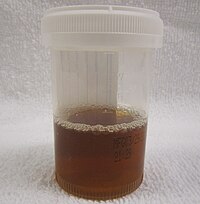
Photo from wikipedia
STUDY OBJECTIVE We report the first teenage case of ketamine-induced transient central diabetes insipidus. CASE SUMMARY The patient was an 18-year-old woman with moyamoya disease undergoing an external carotid to… Click to show full abstract
STUDY OBJECTIVE We report the first teenage case of ketamine-induced transient central diabetes insipidus. CASE SUMMARY The patient was an 18-year-old woman with moyamoya disease undergoing an external carotid to internal carotid bypass and given a low-dose ketamine infusion. After approximately 2 hours in the supine position, with 0.5 Minimum Alveolar Concentration (MAC) of sevoflurane, a propofol infusion at 50 μg/kg/min, a remifentanil infusion at 0.5 μg/kg/min, and a ketamine infusion at a dose of 10 μg/kg/min, this patient had an excessive urine output. Initially, the Foley catheter contained 50 mL of urine. She was given 1500 mL of crystalloid during the case but produced 2700 mL of urine output. Increasing urine output was noted 1 hour into the procedure around the time that the patient experienced a 2-minute Cushing-like response characterized by bradycardia and hypertension. Several I-Stat samples revealed a worsening hypernatremia. The decision was made to check the urine osmolality and treat the patient with 4 μg of desmopressin (DDAVP). Urine output began to slow down to a normal rate of 2 mg/kg/h, as the patient was transferred from the operating room to the computed tomographic (CT) scanning room for a CT and CT angiogram; both were unremarkable. The neurosurgery team waited until the next day to complete the procedure. The procedure was completed successfully and uneventfully the next day without a ketamine infusion as part of the general anesthetic plan. DISCUSSION The Naranjo Adverse Drug Reaction score of 4 suggested a possible relationship between the patient's ketamine infusion and subsequent central diabetes insipidus. The 2 previous cases on this topic have suggested that ketamine, as an N-methyl-d-aspartate receptor antagonist, inhibits vasopressin release in the neurohypophysis. CONCLUSION Urine output, urine osmolarity, and serum osmolarity should be monitored in patients given ketamine anesthetic; desmopressin should be present to prevent dangerous long-term sequela.
Journal Title: Journal of clinical anesthesia
Year Published: 2017
Link to full text (if available)
Share on Social Media: Sign Up to like & get
recommendations!